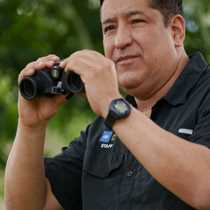Sombrero Chino & Santiago Islands
Today we woke up with the wonderful view of Sombrero Chino and the Bainbridge Islets. These beautiful parasitic cones of Santiago Island were probably formed a long time ago when the sea level was lower. Sombrero Chino, roughly translated into English as “Chinese Hat,” has an extended peculiar shape that is reminiscent of the hats traditionally worn in China.
The early morning was devoted to exploring using our Zodiac fleet. The Zodiac ride was successful, for we had the chance to cover a long distance admiring the striking volcanic landscape and looking for wildlife.
Once onboard, we put on our snorkeling gear to explore the underwater world through deep-water snorkeling. Today we were in an exotic, mostly sunny location and the waters were crystal clear. We were also fortunate with the sightings, for we encountered several marine iguanas foraging on algae, some Galapagos penguins, sea lions fishing, and several white tip reef sharks among many colorful species of tropical fish. At the end of the snorkeling session we enjoyed the cool ocean in a very different fashion: leaping from the National Geographic Islander! Once we were all back onboard, the ship repositioned to the south of the fourth largest island of the Galapagos archipelago, Santiago (also known as James and/or San Salvador Island). During our way to Santiago Island we sailed near Bainbridge Rocks and spotted about a dozen Greater flamingos on an inner salty water lake inside the crater.
In the early afternoon our eager younger explorers joined a special presentation on photography for kids imparted by our naturalist/photo instructor Antonio Adrian. After the presentation, they had a blast learning how to drive our Zodiacs. Later, I was overjoyed to talk about Charles Darwin, one of my favorite topics, with a presentation entitled “Charles Darwin, a retrospective of the impact of Galapagos on his life and ideas.”
In the late afternoon we disembarked at Sullivan Bay for and unforgettable hike on recent lava flows. The lava we observed today is a little more than a hundred years old. It came from an eruption that was witnessed as recently as 1897. Most of the hike was over smooth “pahoehoe” or ropy lava with many “aa” lava patches here and there. Along the way we observed some volcanic formations like: cinder cones, spatter cones, “hornitos” tree casts and more. In a nutshell, this hike is a nature lover or geologist’s dream come true.
As the day was coming to an end we returned to the ship with the company of the last sunrays of the day and a surprise… we finally spotted Galapagos penguins on land! The observation of this eminently interesting and rare flightless species was a golden finale for a spectacular day on the enchanted islands.




